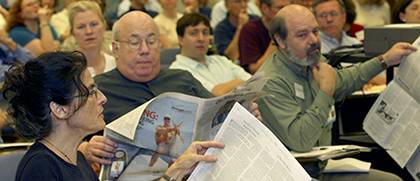Get Media Savvy with Duke’s News Office
Free media training seminar for Duke faculty and staff covers writing op-eds to being interviewed

Three years ago, when Duke faculty member Stephen Kelly would submit an op-ed article he wrote to The New York Times, he wouldn’t hear anything back. Kelly, a visiting professor of the practice in the Sanford School of Public Policy, began to work with Duke’s Office of News and Communications (ONC) to edit his articles and submit them to a syndicate of about 20 newspapers across the U.S. and one in Canada. He also participated in 2012 in ONC’s annual media training seminar.Since then, Kelly has been published five times in The New York Times.“Keep it short. Keep it focused. Make a point,” said Kelly, referencing writing tips he learned from ONC’s training. “They definitely provided a couple of practical tools and the psychological ‘oomph’ to try this out.” ONC is offering its free media training seminar again on Jan. 23 in room 04 of the Sanford School, from 9 to 11:30 a.m. Faculty and staff members interested in working with the media can sign up by emailing Keith Lawrence, the office’s executive director of news and communications, at keith.lawrence@duke.edu by Jan. 16.The training teaches faculty and staff how to be more effective when talking with reporters and others. The session includes discussions and handouts on how to handle an interview, become a source for reporters, write an op-ed article and balance media outreach with other academic priorities.Selected attendees also go through a mock TV interview, in which their media interview is recorded and then reviewed with the class. More than 500 Duke faculty and staff members have gone through the training, which has been offered for more than a decade, said David Jarmul, Duke’s associate vice president of news and communications. “We do get a broad mix of people,” Jarmul said. “For them, actually, that’s part of the fun of it. They get to meet faculty and other colleagues from across the university who they might not interact with otherwise.”
Getting In The News
Duke faculty members are in the news in increasing numbers, and usually on subjects of timely interest. From Elizabeth Frankenberg on the anniversary of the 2004 South Pacific tsunami to William Darity on employment prospects for young African-American males, Duke faculty are applying their research to the news of the day.
But first, reporters have to know that Duke has experts who are available to provide insights and perspective for their news stories. An article in CASE Currents explains how Duke faculty are showcasing their research in the media.
The training concludes with an open-ended discussion with invited faculty members who’ve received a lot of media attention during the past year. They discuss how the attention affected both their professional and personal lives, such as how they juggled interviews with their research, teaching and raising children.
“Any given day, you’ll see Duke faculty featured prominently in a lot of A-list type of media outlets, along with many others,” Jarmul said. “That doesn’t happen by accident. Many of those people have gone through the training and or have worked with us to learn how they can be more effective in this process. It works.”Kelly, the Sanford professor who has been published in The New York Times, was previously a journalist at the Charlotte Observer. He said writing op-eds about land border disputes with Canada and gasoline prices across the country has given him an opportunity to rediscover his “journalist voice.”“When I teach my classes on public policy here, it involves writing memos, State Department-style memos, and the principles are the same as with good journalism,” Kelly said. “You’re dealing with readers who are time-stressed; you have to write in a way that’s compelling. You have to write what’s important, and tell them that upfront.”